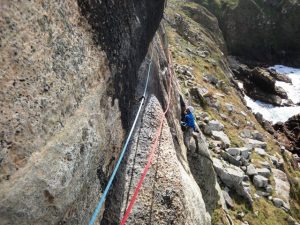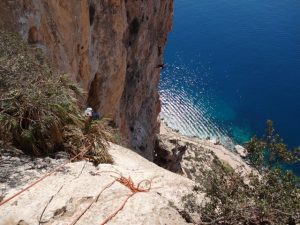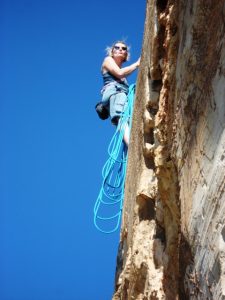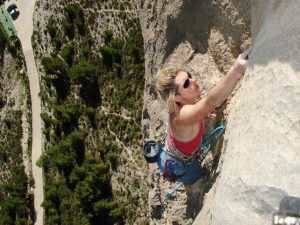Multi-pitch climbs are often associated with trad climbing but in this country and abroad there are multi-pitch sport routes too. The beauty of multi-pitch climbing is that you become involved in the adventure of the climb and as you gain height, the feeling of affinity with the rock and nature becomes overwhelming. You may also look ahead and wonder if you will be able to complete the climb and doubts might creep in.

A multi-pitch climb can take anything from a couple of hours to several days depending on the climb you choose. You feel committed on big routes and often cannot anticipate problems or the level of difficulty, even when you have a guidebook for the route. Then there’s the descent; will you be able to find the abseil points or the way off. Will the ropes get tangled or will the path be obvious?
To succeed on multi-pitch climbs your rope work must be meticulous. Care and time must be taken to make sure everything is right. You don’t need to be fast, but you need to be efficient and have a well ordered system. You shouldn’t feel rushed as this is when mistakes are made, so plan ahead, begin the climb early in the day, enjoy the process and keep checking everything you do. With good methodical rope work you will save time.

Good route finding is time saving, whereas going off route wastes time and can get you into all sorts of trouble, so remember to take a copy of the route guide including adjacent routes if you need to escape. I tend to take photographs of the guide and take my camera with me which is great for zooming in on detail.
The best way to enjoy a multi-pitch climb is to share and alternate the leading. The changeover at stances is so much quicker, as at the belay stance, the leader brings up the second, who strips the gear from the route as he ascends and then once at the stance the rope is already on the top and ready to go. Both climbers must make themselves safe on the belay before any exchange or rearrangement of gear and the belayer may have to turn the belay device round depending on the line of the next pitch.

Sometimes you have to take a hanging stance in which case the rope has to arranged in lap coils over the feet or waist of the belayer. The coils are lapped from long to short so the rope feeds off easily for the lead climber and avoids the rope snagging should the wind pick up.
You need to anticipate how long the route will take you based on your climbing ability, the route description and the weather forecast. For routes that need several days to complete you will need a window of good weather to be successful. How much food and water do you need or spare clothing? Do you need bivvy equipment? Are you fit enough to take on the route?
Obviously if you are contemplating progressing to multi-pitch climbing start small; you could break a familiar single pitch route into several pitches and do climbs within your grade. Build on your experience and for the greatest benefit employ an MIA, MIC or Guide to teach you. Once you are ready to go it alone you have a lot to look forward to as multi-pitch climbing can take you to some remarkable, beautiful, remote and unspoilt areas of the world as well as giving you experiences you will never forget.
